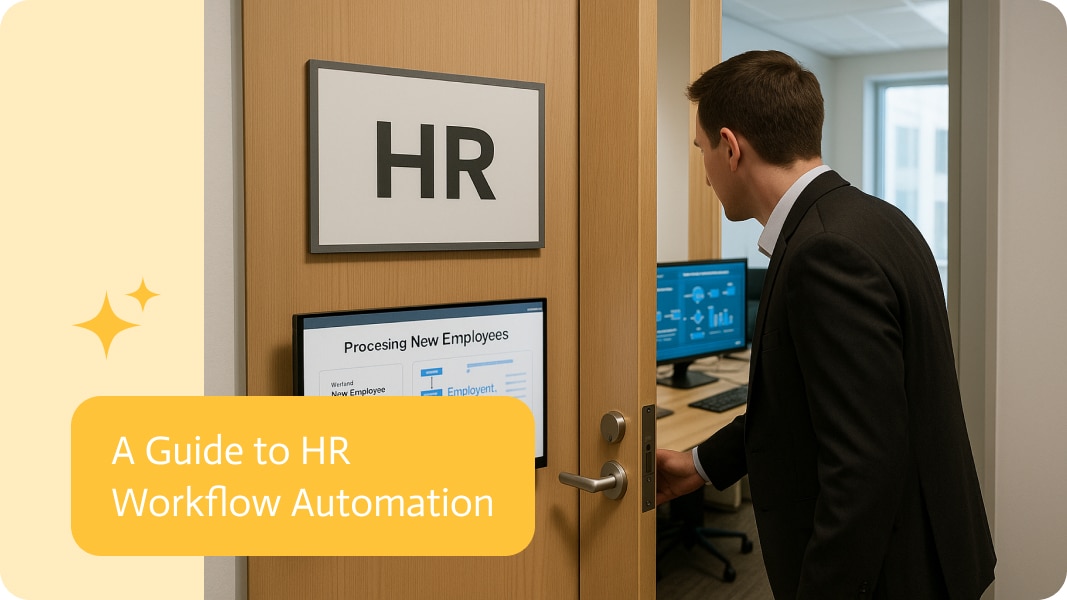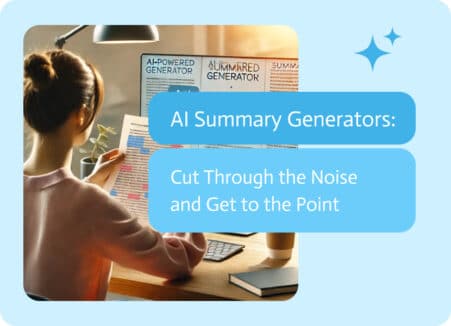

A Guide to HR Workflow Automation
HR work used to mean stacks of paperwork and endless email chains. With workflow automation, special software now picks up that freight and keeps things rolling on its own. Click once, let the program do the repeatable, tedious stuff, and watch time open up for more interesting challenges.
What Is HR Workflow Automation?
The phrase sounds high-tech, but the idea is simple. Imagine a tireless digital assistant that zips through routine HR chores while you grab a coffee. That robot helper never misses a deadline, never loses a form, and always sticks to company policy.
Let Technology Do the Heavy Lifting
Instead of doing math in a spreadsheet, shooting reminder emails, or pestering managers for thumbs-up, HR pros can flip switches and let workflows run in the background. Speed? Check. Accuracy? Double-check. Piles of finish-later paperwork? Poof, gone.
Here’s a quick scenario
A college graduate accepts an offer letter. In the old, manual world, HR would:
- Fire off a welcome email, then pray it lands
- Ping IT to make sure logins and phones are ready
- Hunt a time slot on the calendar for orientation
- Chase the new hire for W-2 forms
- Remember to add the name to payroll before payday
One click on an automated dashboard, however, sends a silent domino chain in motion. Emails go out, tickets hit the IT queue, calendars fill, and payroll updates all without a single nudge from a busy human. Messy bottlenecks shrink to nothing, and everyone can focus on the fun part: getting the new team member settled in.
Core Areas of HR Workflow Automation
HR teams juggle a thousand moving pieces every day. The true power of workflow automation is that it takes the repetitive, manual grunt work and turns it into smart, streamlined systems that just work. Here’s a deeper dive into the areas where automation makes the biggest difference
Companies get exactly one shot at a first impression. Miss it, and the new hire wonders if they signed up for the right place.
When onboarding is done by hand, problems pop up fast: forgotten emails, delays in system access, and training sessions that simply drift away. Swap those scattered steps for an automated flow, and the whole thing glides along like a well-oiled machine.
Inside a good automation setup, the following tasks run on their own:
- Welcome emails and paperwork buzz out the moment the offer is signed. Contracts, tax forms, NDAs, and even benefits packets arrive without anyone chasing signatures.
- Compliance checks and orientation courses add the new person without any extra keystrokes. Department-specific training lands on their dashboard as soon as they log in.
- IT gets a ping to spin up email, Slack handles, and all the other logins before the employee walks through the door.
- Calendar links for meet-and-greets with managers, buddies, and mentors slot themselves throughout the first couple of weeks.
- Every department learns about the rookie in real time. HR stops having to cut and paste messages; the team sees the name, title, and start date automatically.
The payoff is huge. Fresh employees feel welcomed and ready to roll on day one, so they stick around longer. HR, meanwhile, can stop babysitting a dozen chat threads and finally get back to the fun parts of people work.
2. Leave and PTO Requests
Nothing eats up time quite like a messy leave request process. Employees update spreadsheets, managers filter through a cluttered inbox, and nobody really knows if a day off is approved. It feels like chasing your own tail.
Switch to automation, and that headache vanishes in one click. A self-service portal lets staff ask for time off, then a digital workflow zips the request to the right boss without anyone guessing who’s next in line.
Calendars update automatically, so the team can see at a glance who’s in the office Wednesday and who’s headed to the beach. Payroll chips in too, adjusting leave balances the moment a manager hits approve.
Some systems go a step further, flagging patterns that scream trouble, like someone calling in sick every third Friday or hoarding vacation days until they expire. HR spots those red flags early, often before they turn into real drama.
The bottom line? The experience is smooth for workers and lightens the paperwork crush for HR. Everything is logged, debates about who asked first disappear, and everyone walks away feeling treated fairly.
3. Hiring and Recruiting
Hiring moves fast, sometimes too fast, and that speed can trip up even the sharpest teams. Automation doesn’t just quicken the pace; it slices through the noisy parts that make candidates feel ignored.
Smart technology starts by blasting a single job ad to LinkedIn, Indeed, and the company page, all at once. A few minutes later, resumes creep in from every corner of the Internet.
An applicant tracker scans those documents for keywords, experience, and culture fit, then pulls the most promising names to the top. Recruiters still read every application, but now they start with the folks most likely to stay long-term.
Interview schedules fill in without back-and-forth email volleyball. Reminder texts keep candidates from wandering around the lobby, and three-stage assessments help cut bias before a hire is ever made.
That kind of setup doesn’t guarantee every hire will work out perfectly, but it sure gives good people a fighting chance. Less clutter, fewer mistakes, and a chance for every candidate to feel respected from the click of the apply button to the welcome email.
Interview scheduling can feel like herding cats, except a good calendar-sync tool turns that chaos into calm. Candidates see only the real openings and book themselves in without anyone chasing emails.
Once a slot is secured, an automated email chain springs into action. The candidate gets a confirmation, the panel gets a heads-up, and if the news is bad, that message still goes out, all without a recruiter lifting a finger.
All the interviewers then fill out the same scorecard template, maybe even from their phones. The system collects those notes and spits out a summary, letting the hiring manager spot the standout candidate in minutes instead of hours.
Less back-and-forth speeds up the entire pipeline, makes it fairer, and lets recruiters spend their energy on real conversations rather than clerical juggling. The paperwork, in other words, finally runs itself.
4. Performance Reviews
Most people greet annual reviews like they would a dental appointment: necessary, maybe, but pretty painful. Workflow automation slides in and quietly rewrites that script.
Employees and managers get system nudges that feel a bit like friendly GPS directions, wrong turn? Rerouting now. Nobody can say they forgot the deadline because the deadline pops up three times.
A uniform form forces everyone to use the same criteria, so a marketing rep and a compliance officer are judged on apples and apples. Collecting self-assessments alongside 360 feedback happens in one click, and every stray file is finally invited to the party.
Goal and skills progress sit in a dashboard, green and red bars telling the story at a glance. Trend charts let HR catch whiffs of burnout or team wins weeks before they grow obvious.
If once-a-year booking makes jaws tighten, quarterly or even project-based mini-reviews spread the feedback out. Done that way, the talk feels more like regular check-ins and less like an interrogation under bright lights.
Writing reviews used to feel like busywork, no fun, no energy, just boxes to check. New tools turn those dull moments into clear, useful feedback that teams can act on right away. People still talk about compliance, but now the spotlight is on real growth.
5. Employee Offboarding:
Every worker who walks out the door, whether with a smile or a shrug, deserves a cleanup that feels fair. Half the time, the exit is messy because no single person decides who’s in charge of the list, so items slip through. A smart automated offboarding flow hands each task to the right person, locks down sensitive data, and tracks the hand-offs, turning chaos into calm.
Why HR Workflow Automation Is a Game-Changer
If you’ve been mulling over whether to jump in, look at what automation actually hands you.
Saves Time
HR is already a paper jungle; turning the routine into code clears out some of those vines. You free up hours, maybe even a whole day, to dream bigger instead of hitting Send over and over.
Reduces Human Error
A program runs by a plan, not by how many cups of coffee someone has had. Automatic steps cut the little slips, someone forgetting to authorize or mistyping a hire date that nibble at your credibility.
Improves Compliance
One missed checkbox on a form can make a headache the size of a mountain. Automated checklists march through the rules, ticking every square without ever deciding that today feels like a holiday.
Enhances Transparency
No more mysterious black holes between asking for leave and getting a response. Dashboards light up the status, so everyone, including that nervous employee, knows where the bottleneck is.
Boosts Employee Experience
Waiting weeks for a simple signature is practically a relic now. A few clicks, some background logic, and the grunt work is done, letting staff focus on their real jobs, not on tracking paper flowers.
Tools That Make It Happen
The idea of automating HR tasks once sounded futuristic, yet plenty of platforms today prove otherwise.
- BambooHR gives fast-growing teams an easy way to set up workflows without staring at long user manuals.
- Workday serves larger enterprises by stitching payroll, hiring, and performance management into one sleek package.
- Zoho People keeps costs in check and still lets small-to-midsize businesses tweak nearly every setting.
- SAP SuccessFactors scales smoothly for corporations that already lean on SAP’s broader ERP suite.
- And if writing code feels like a foreign language, Noca lets HR pros drag and drop their way to custom automations.
How To Leverage Noca For Your HR Solutions
Noca AI helps make HR tasks way easier by acting like a central hub that links all your HR tools. It’s built so anyone can create smart workflows, even if they don’t know coding. This means you can automate things from when you first start hiring to managing how workers perform and handling their info.
For instance, Noca can schedule interviews, post job openings, and use AI to review resumes. Additionally, it automates onboarding processes, such as requiring new hires to sign company policies and submit paperwork, which facilitates the start of a job. Through online portals, Noca can also handle routine employee requests like granting time off or responding to inquiries about benefits, as well as reminding employees about performance reviews and consolidating all feedback.
In Conclusion
HR workflow automation is more than just easy; it gives you an advantage. Instead of burning out your HR team, automation lets companies grow faster, keep their best people, and stay within the rules.
Automation doesn’t take away the human element of HR, it just lets HR focus on the important stuff, like making better workplaces.
If your HR team is still swamped with forms, tracking down signatures, and entering info by hand, then it’s time to quit doing that. There’s a better, faster, and more human way to work. It starts with automating the workflows that slow you down.


